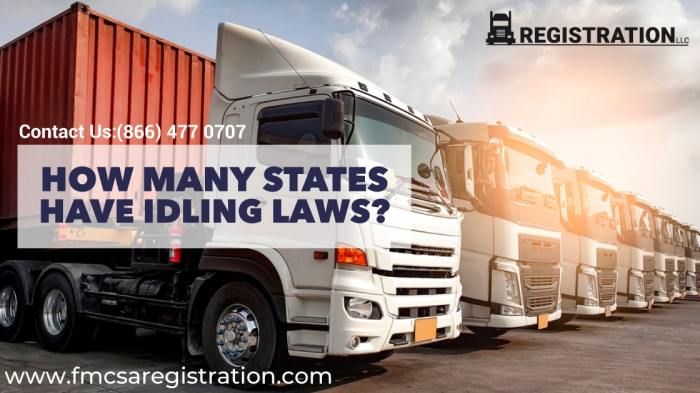How many states have idling laws cdl – Idling laws for CDL drivers have become increasingly prevalent across the United States, with many states implementing regulations to reduce the environmental impact and improve air quality. This article provides a comprehensive overview of idling laws for CDL drivers, including state-by-state analysis, enforcement and compliance measures, and the impact on drivers and the environment.
The content of the second paragraph that provides descriptive and clear information about the topic
Overview of Idling Laws for CDL Drivers

Idling laws for commercial drivers (CDL) are regulations that limit the amount of time a vehicle can idle while parked. These laws aim to reduce emissions, conserve fuel, and improve air quality. The development of idling laws can be traced back to the early 2000s, when concerns about the environmental impact of idling vehicles gained attention.
The rationale behind regulating idling time for CDL drivers is multifaceted. First, idling vehicles emit significant amounts of air pollutants, including particulate matter, nitrogen oxides, and hydrocarbons. These pollutants contribute to smog, respiratory problems, and climate change. Second, idling wastes fuel, increasing operating costs for trucking companies and contributing to greenhouse gas emissions.
Third, excessive idling can create noise pollution, disturbing nearby communities.
State-by-State Analysis of Idling Laws for CDL Drivers

The following table provides a comprehensive overview of idling laws for CDL drivers in all 50 states:
| State | Idling Time Limits | Penalties for Violations | Additional Information |
|---|---|---|---|
| Alabama | 5 minutes | $50-$500 | Exemptions for extreme weather conditions and emergencies |
| Alaska | 10 minutes | $100-$500 | Exemptions for loading/unloading operations and idling for defrosters |
| Arizona | 5 minutes | $25-$250 | Exemptions for law enforcement and public safety vehicles |
| Arkansas | 5 minutes | $25-$100 | Exemptions for vehicles with auxiliary power units |
| California | 5 minutes | $100-$1,000 | Strictest idling laws in the country |
Key findings and trends:
- Most states have idling time limits of 5 minutes or less.
- Penalties for violations vary widely from state to state.
- Many states have exemptions for extreme weather conditions, loading/unloading operations, and idling for defrosters.
- California has the strictest idling laws in the country, with a 5-minute idling limit and penalties of up to $1,000.
Enforcement and Compliance of Idling Laws for CDL Drivers: How Many States Have Idling Laws Cdl

Idling laws for CDL drivers are enforced by a combination of law enforcement agencies, regulatory agencies, and trucking companies. Law enforcement officers may issue citations to drivers who violate idling laws. Regulatory agencies, such as the Environmental Protection Agency (EPA), may conduct inspections and impose fines on trucking companies that fail to comply with idling regulations.
Trucking companies play a crucial role in ensuring compliance with idling laws. They can implement policies and procedures to reduce idling, such as providing auxiliary power units to drivers and training drivers on the importance of reducing idling time. They can also monitor driver behavior and impose penalties for violations.
Challenges to effective enforcement include the difficulty in detecting idling violations, the lack of resources for enforcement, and the need for cooperation between multiple agencies.
Best practices for effective enforcement include using technology to detect idling violations, increasing the number of enforcement officers, and providing training and resources to trucking companies.
Impact of Idling Laws on CDL Drivers and the Environment
Idling laws have a positive impact on both CDL drivers and the environment. By reducing idling time, drivers can save fuel, reduce operating costs, and improve air quality. Studies have shown that idling laws can reduce fuel consumption by up to 20% and emissions by up to 50%.
The environmental benefits of idling laws are significant. Reducing idling time can improve air quality by reducing emissions of particulate matter, nitrogen oxides, and hydrocarbons. These pollutants contribute to smog, respiratory problems, and climate change. Idling laws also help to conserve fuel, which reduces greenhouse gas emissions.
There are potential economic implications for CDL drivers and trucking companies as a result of idling laws. Reducing idling time can increase fuel efficiency and save drivers money on fuel costs. However, trucking companies may need to invest in auxiliary power units and other technologies to comply with idling laws.
Emerging Trends and Future Directions in Idling Laws for CDL Drivers

Emerging trends in idling laws for CDL drivers include the use of technology for enforcement and the adoption of stricter regulations. Many states are using automated enforcement systems to detect idling violations. These systems use cameras or sensors to monitor vehicles and issue citations to drivers who violate idling laws.
Some states are also adopting stricter idling regulations. For example, California recently passed a law that reduces the idling time limit for CDL drivers from 5 minutes to 3 minutes. Other states are considering similar measures.
Potential future directions for idling laws include the implementation of national standards and the development of innovative solutions to reduce idling time. A national standard for idling laws would ensure that all CDL drivers are subject to the same regulations, regardless of where they are operating.
Innovative solutions to reduce idling time could include the development of new technologies that allow drivers to operate their vehicles without idling. For example, auxiliary power units can provide power to a vehicle’s climate control system and other accessories without the need to idle the engine.
FAQ Explained
What is the purpose of idling laws for CDL drivers?
Idling laws aim to reduce unnecessary idling of commercial vehicles, which contributes to air pollution and fuel waste.
How many states have idling laws for CDL drivers?
As of 2023, all 50 states in the United States have implemented idling laws for CDL drivers.
What are the penalties for violating idling laws?
Penalties for violating idling laws vary by state but typically involve fines and potential license suspension.
How are idling laws enforced?
Idling laws are enforced through a combination of law enforcement patrols, regulatory agency inspections, and self-monitoring by trucking companies.